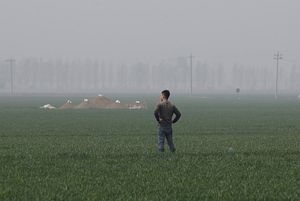Building a model city has a long tradition among China’s reform-era leaders. Shenzhen’s rise from fishing village to manufacturing powerhouse is forever connected with the name Deng Xiaoping. Jiang Zemin tied his legacy to the development of Shanghai’s Pudong District into China’s leading financial center. Now Xi Jinping aims to connect his name with Xiongan, a sustainable and smartly planned parallel city right next to Beijing.
For a leader who has re-centralized power and tightened political control over China’s economy and society, it seems fitting that Xi’s city-building ambitions aim straight at the nation’s capital. According to the official joint announcement by the Communist Party Central Committee and the State Council on April 1, Xiongan would become “another zone of national relevance after Shenzhen and Pudong.”
And yet, in many ways, Xiongan is designed as an antithesis of Shenzhen and Pudong. The latter two started out as experiments with free market reforms, while the plans for Xiongan, which translates to “magnificent peace” in English, follow a strictly state-led approach. Imperial Beijing’s modern sister city will be a symbol of political power rather than economic development.
Back in 1984, everyone with an entrepreneurial mind could try his or her luck in Shenzhen. In the case of Xiongan, the Chinese government will decide which enterprises and institutions will be based there – and it will even select the new city’s residents. As of now, outsiders are not allowed to register residency (hukou) in Xiongan, not even through marriage to a local resident. Private real estate transactions are banned, and companies from other parts of China do not have access to the local market.
Xiongan represents a clear break between Xi and his predecessors as the head of the state and Party since the 1980s. Deng tossed many ideological tenets aside when he set out to jump-start China’s economy after the Mao era. In the early days of China’s reform and opening policy, Shenzhen started as an experiment on China’s periphery. It was the test laboratory for introducing market reforms and for building an export industry. Through its vicinity to Hong Kong, it provided China with a “window to the world.”
Jiang continued to integrate China into the global economy, leaving room for domestic experimentation. In the 1990s, the development of Pudong was a government-incentivized push to build up the financial sector that was needed to support China’s economic boom. It served Jiang’s ambition to help his internationally minded home city restore its former glory.
Xi has re-centralized power and tightened political control over China’s economy and society. The plan to build a new metropolitan region next to Beijing is an unprecedented top-level political experiment. As far as known from official documents and statements, Xiongan will function as a backup system to the nation’s capital and provide an alternative development model. Financial markets and the public have high expectations for the “green” and “smart” city, which China’s leadership envisions as a high-tech hub and a laboratory for intelligent city planning.
Beijing may be China’s historic, cultural and political center, but the combined problems of overpopulation, traffic congestion, rising real estate prices, and unhealthy levels of pollution have harmed the city’s attractiveness. At the same time, the widening economic gap between the privileged and educated urban population and the poor hinterland has created social tensions. Unlike in Shanghai, Beijing’s success never “trickled down” to the rural hinterland.
The leadership’s hope is that Xiongan, which combines the counties Xiong, Rongcheng, and Anxin in Hebei province, will take some of the pressure off Beijing while lifting the surrounding rural areas out of poverty. The project also has clear security implications: Northern China suffers from water scarcity, and the South-North Water Diversification Project, which was meant to secure Beijing’s water supply, has drawn severe criticism due to its many detrimental side effects on the environment and human livelihood. Xiongan would alleviate this problem due to its location near the Baiyang Lake, the largest freshwater reservoir in northern China.
Stretching out Beijing’s resources even has a military rationale. As the historian Luo Tianhao has pointed out, the over-concentration of resources had disastrous consequences for China’s then-capital Nanjing when it was attacked and occupied by Japan in the 1930s. Back then the economic paralysis of the capital had severe affects on its dependent regions.
These considerations could partially explain speculation that a number of Beijing’s highly concentrated technological and cultural resources, from tech companies in Zhongguancun to Tsinghua University’s science and engineering units, will likely be relocated to Xiongan.
Xi is taking a high risk with trying to implement such an ambitious vision. The challenges of implementing this high cost project are enormous. If it fails, Xiongan could turn into a showcase illustrating the limitations of the current top-down approach to political leadership and economic development.
If it succeeds, it has the potential to become a powerful symbol of Xi’s “China Dream.” A thriving Xiongan would prove that China’s success does not depend on adopting “Western” economic, political, or social concepts, but that it can achieve modernity on its own terms.
George G. Chen is a research associate at the Mercator Institute for China Studies (MERICS) and an expert on China’s judicial system and legal policies. He is the author of “Copyright and International Negotiations: An Engine of Free Expression in China?,” a monograph published in 2017 by Cambridge University Press.

































